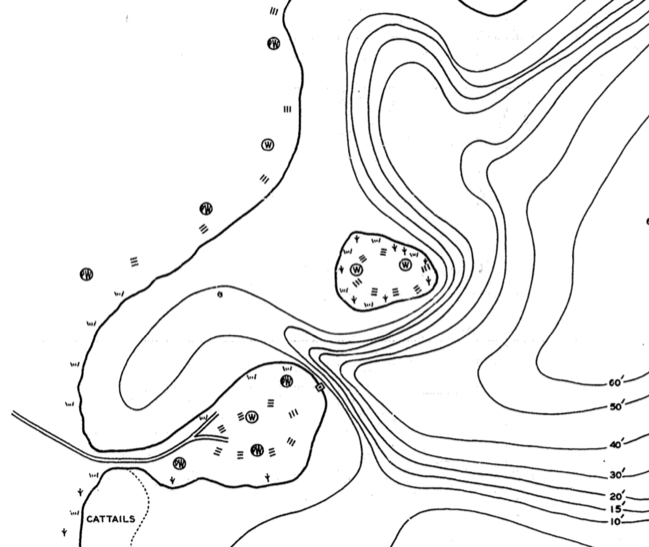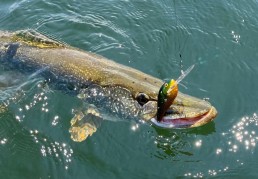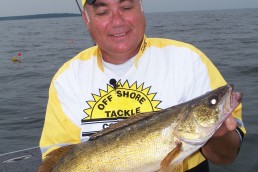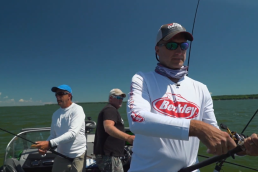Precision Trolling for Summer Predators
SHARE THIS POST
My humble 16-foot aluminum fishing boat was rocking and rolling in large boat wakes pummeling us from different directions, making the stubborn fight from an angry brute of a summer pike more challenging on this busy midwestern lake. Would I join the powerful 3-foot plus beast in the drink, trying to wrestle her into submission, entertaining the power boaters? I hoped not.
But it was fun, just like so many other fond memories from mid-summer contour trolling trips. It’s been a favorite July and August pastime of mine for decades. It works well not only for pike, but also bass, walleyes, even muskies; it’s a top tactic for any major predator species when the pattern sets up.
Here’s the precise way I enjoy this hot-summer-weather opportunity:
Contour trolling conditions
Hot; very hot. The hotter the weather, the better. In my southern Michigan region, I like surface water temperatures at 80 degrees or more, which normally results from plenty of days in the 90s for air temperature highs. This squeezes many of the lake’s larger predators into a tight zone, assuming the lake stratifies, like most lakewith large deep areas do in mid- to late summer. Much above the thermocline, the water is too warm for some species, except for bass which still tolerate the warmer waters. Below, the water has too little oxygen to support fish life.
Further north, the magical 80-degree surface temperature mark is not as critical. My occasional forays northward, mainly in upper Michigan, suggest mid- to upper 70s for water surface temps. Regardless, it’s best during the hottest summer weather of the year.
On my collection of favorite summer trolling lakes, the optimum depth zone is precise, like 16 to 18 feet, or 15 to 20 feet. This is usually a very narrow band of water on lakes with steep drop-offs, which I prefer for defining fish location. Most waters I fish are hundreds of acres in size, however. Much bigger, deeper lakes tend to have thermoclines set up deeper than that.
Sophisticated electronics show it better, but my outdated version still shows the baitfish and larger fish marks; also, the deep weed growth and edge, if decently defined. Plus, violent strikes let you know soon enough if you’re accurate in your presentation.
Go accurate or go home
I’m not saying that you’ll catch nothing by sticking rods in holders and cruising around the neighborhood of where you expect summer predators to be. You’ll probably still catch a few fish here and there, especially on waters with strong fisheries. But that, compared to precision trolling, is a night and day difference. I consistently encounter less-obsessed trollers, fishing multiple lines, having slow days at best, while dozens of fierce pike, bass and walleyes were smashing my single lure. I wish them well while understating how my day is going, since I’m selfishly thankful they aren’t exploiting the fishery.
So, how to be accurate when trolling? I use one hand-held rod and run a tiller motor for best control (in my opinion), making constant steering and rod adjustments to present lures the best way. One fishing partner is acceptable, at least in my boat, because they are also handling their rod through all the boat maneuvers to keep their bait where it needs to be. Trolling just one more line can limit the tight turns, speed changes, and moving rods higher or lower as we continually probe the edge of the contour as best we can. One other line can still get tangled in mine or the prop in the tightest spots if my partner doesn’t pay attention well enough.
I usually use a slow speed of around 2 mph to accommodate all the required boat maneuvers, instead of faster speeds that don’t let me correct in time. Slowing even more, or idling at times, lets the baits float up some when needed against the weed walls. But if you’re not running into weeds at least sometimes, you aren’t hitting the zone best. I’ve seen others, including Spoonplug fans, doing fine with one rod and good accuracy at faster speeds. I’ve tried it but prefer the forgiveness of slower speeds and baits that float up when it helps.
A “lake-long casting retrieve” is one way to put it. Think about how carefully you might work a soft plastic or other bait while retrieving it in casting situations, next to or through cover on a drop-off, using different rod moves and twitches along the way. It’s best done with constant focus on what the bait is doing down there. Now apply that same thinking to precise trolling the whole time—every minute of it. Rod holders don’t cut it for the best results. Also, rod maneuvers are major triggers, and most strikes by far occur while doing that.
Are you enjoying this post?
You can be among the first to get the latest info on where to go, what to use and how to use it!
Pike are notorious followers—also muskies—but bass and walleyes also respond well to changes in a lure’s path. It helps greatly to trigger their strikes with twitches, pauses so baits float up some, and long, accelerating, forward rod sweeps forward with bigger pauses, mixing things up.
It’s exciting fishing when it’s on, and much of the time, it is. Often, it triggers furious, explosive strikes when holding the rod and relentlessly provoking fish. Your humble author has logged literally thousands of summer predators caught this way, with hundreds of them high-quality versions. It’s a thrilling rush I never tire of!

Tackle and other tips
Nearly any bass or walleye rod works great for this fishing approach, although I prefer a decent length around 7 feet with some backbone for less forearm fatigue. A rod holder in the right spot on the gunwale—not to place the rod in so much, but more to brace and pivot the held rod some of the time—is a nice plus on longer outings.
The deep crankbaits I use have significant to heavy resistance, even at slow speeds. I strongly prefer braided lines to feel the baits’ vibration and any weed debris I may need to clean off them. Personally, I like 30- to 50-pound braid for its thin diameter and optimum bait action and feel, with some weed-slicing benefits.
I remember my stretchy mono line trolling days with occasional long, accurate passes in prime areas that had me wondering why I didn’t get a strike; only to find out I was dragging just enough debris on the lure to reduce its effectiveness, which I didn’t notice. It would take a truly desperate fish to hit that, and I don’t recall it ever happening.
I almost always run deep crankbaits with confidence at specific depths, although if you are accurate with trolling weights and other baits, or heavy spinnerbaits which I still use at times for to reduce weed cleaning, they can work well. Sinking baits have their obvious disadvantages in this method, though. I try to consistently keep baits themselves up a few feet from bottom or weeds—say 14 feet down over 17 feet—although it’s almost impossible to hold an exact depth more than a few seconds, or at most minutes, on a lake with involved contours.
I bring an assortment of deep cranks in popular mainstay colors like chartreuse-based patterns, silver and blue, or similar looks. I believe it’s mostly about accuracy, including depth control. But some days, specific baits and color patterns emerge as clearly best, even by far. So, bring a decent variety along to make adjustments.
Tip: Place a small split shot up a few feet from the wire leader (if you are on waters that have pike or muskies). The small weight is not to get the bait deeper. It can help deflect suspended weed debris or hold onto some of it before it slides down the line, requiring another pause to clean off the lure.
Speaking of pauses, always work your crankbait in carefully with trigger moves when the boat is idling to net a partner’s fish; that has high double-header potential. Always work it in that way anytime you’re completing a run.
A favorite additional technique I like could be called the “Suicide Corner”: A tight corner in the weed wall that even a skilled troller may not get their bait well enough into. So, run straight up in there instead, throw the motor into neutral as you coast pass the end of the “V,” and retrieve that bait right in there, hitting weed wall or a fish, whichever comes first. I usually pause toward the end to raise the bait anyway, so it’s not always a weed mess if you don’t get a strike.
Well, there you have it. Tedious I know, but I hope useful. If you cash in on this, please note that careful, quick release of most summer predators is critical to conserve their populations when they are concentrated like they are in these situations. Occasional fillets are best in the colder water months, anyway.
Now, go forth and enjoy some hot summer predator trolling with precision!
MWO
SHARE THIS POST
Did you enjoy this post?
You can be among the first to get the latest info on where to go, what to use and how to use it!



